
John Wayne once described himself as "just the paint for the palettes" of directors like John Ford and Howard Hawks, the filmmakers who steered him in films such as "Stagecoach" and "Red River." Such modesty was characteristic of "The Duke," whom Orson Welles described as one of the best-mannered actors in Hollywood. Yet Wayne was doing himself a disservice, for while he did benefit from the tutelage of two great filmmakers, he also worked long and hard to create the persona of "John Wayne," a figure with a distinctive gait, an easy drawl, and tough morality.
To explore the career of John Wayne is to explore five decades of Hollywood history. Wayne acted opposite everyone from Barbara Stanwyck and Maureen O'Hara to Henry Fonda, James Stewart, and Kirk Douglas. The list of directors he worked with is just as impressive, too.
So, where does one start with John Wayne, both the complicated man and the cultural construct? Here are 27 films that trace the good — and some of the bad — of one of America's most enduring icons.
The Horse Soldiers
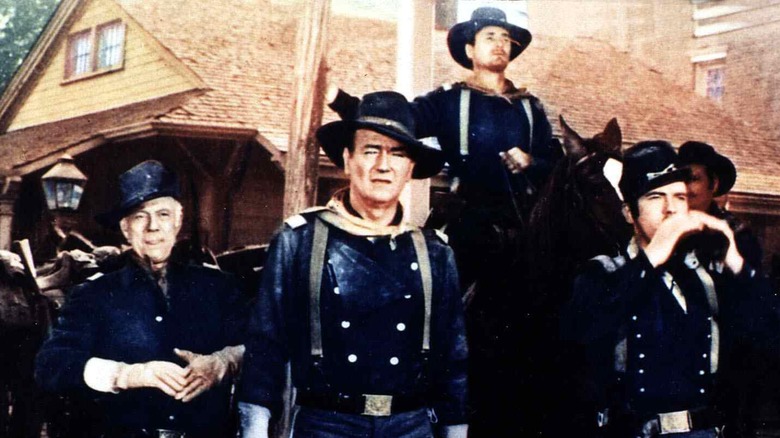
"The Horse Soldiers," a Civil War drama, pitches John Wayne against one of my favorite actors of the era, William Holden. Such a pairing is interesting at face value, but their characters share a dynamic that makes the match up even more compelling. Wayne plays Colonel John Marlowe, a hard-nosed Union soldier with a clear sense of what's right for his men. However, Holden's Major Henry Kendall, a doctor conflicted by his medical and military oaths, has no such certainty. Naturally, these sensibilities cause conflict; first, the two men trade terse words, and later punches.
"The Horse Soldiers" is a middling entry in Wayne's career, but the production is notable for several reasons. For the film, Wayne and Holden earned $775,000 each and 20% of the box office, which was an extremely lucrative deal by the standards of the late 1950s. Another anomaly is the death of stuntman Fred Kennedy, who was killed when he fell from a horse and broke his neck. John Ford knew Kennedy for years, and was so devastated by his death that he lost all interest in the production.
McQ
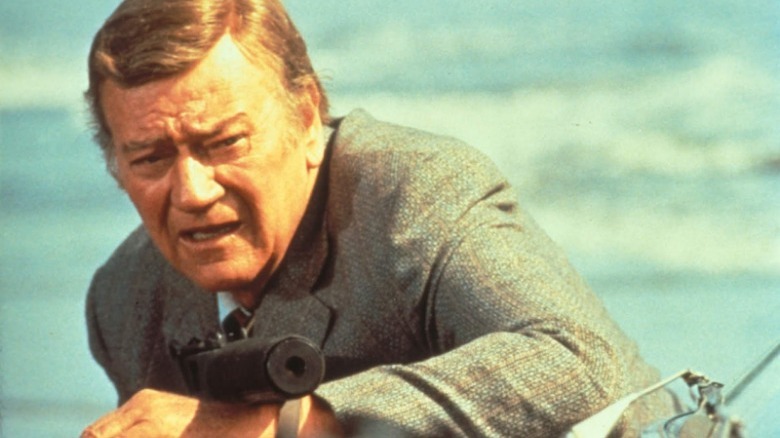
In the closing months of the 1960s, high on the success of "True Grit," John Wayne turned down the lead role in "Dirty Harry," a film and a character that would become a pillar of Clint Eastwood's career. The Duke lived to regret his decision and, joining a wave of imitators, accepted the lead in "McQ," a stodgy police procedural about drugs, corruption, and a mean anti-hero cop called Lon "McQ" McHugh.
Several measures are taken to spice up McQ's anti-hero credentials. First is the Pontiac Firebird Trans Am, which Wayne never looks right in. That McQ would drive something American made is unquestionable, but I think he would have chosen something better suited to his age and padded stature. Something leisurely like a Lincoln, Cadillac, or Oldsmobile.
The other, more successful anti-hero measure is the Ingram MAC-10 submachine gun, which is Lon McQ's answer to the .44 Magnum revolver. The Duke's porky fingers are a better fit on the trigger than the Trans Am steering wheel, but the gunplay does not save "McQ" from being a bit of a damp squib.
Hondo

Wayne gives another easygoing turn in "Hondo," a short film about homesteading and conflict. The latter may seem the better fit for a John Wayne vehicle, but it is actually the homesteading that charges the appeal of John Farrow's late career feature.
The 84-minute film establishes the main characters within the first ten minutes. Hondo (Wayne) and his dog Sam arrive at a homestead run by Angie (Geraldine Page) and her six year old son Johnny (Lee Aaker). You sense her fear but Hondo is another of Wayne's chivalrous gentlemen. It's a familiar and easy role, yet watching Angie fall for the Duke's amiable ruggedness makes for a watchable old fashioned romance.
A few years ago, back when the "thug life" meme was popular on social media, you may have seen a clip of John Wayne throwing a boy into a river as a very literal "sink or swim" approach to parenting. Well, that scene was taken from "Hondo," and it is a harsh but playful example of Wayne's no-nonsense philosophy.
The Long Voyage Home
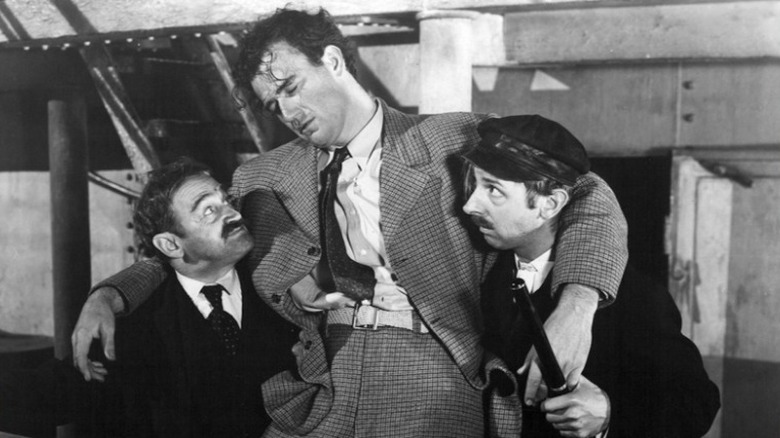
"The Long Voyage Home" is about seafaring men during the early days of the Second World War. It may be a smaller title in the John Wayne and John Ford canon, but it is a very curious artifact for any student of film history.
One of the oddities is Wayne's performance as Olsen, a Swedish seaman. It was the actor's second leading role in a John Ford picture and it required the budding A-lister to drop his easy drawl and adopt a Swedish accent, which, as you can imagine, was executed with mixed results. I'm not sure what Swedes will make of it, but I think the Duke does an admirable job. His attempt relies on grammar rather than pronunciation — "I go home," "We live on farm" — but Wayne captures Olsen's youthful softness, which is an important part of the story's pathos.
Another notable element is cinematographer Gregg Toland, who implemented his deep focus technique on this film, something he'd replicate to industry-changing effect the following year in the immortal "Citizen Kane."
3 Godfathers
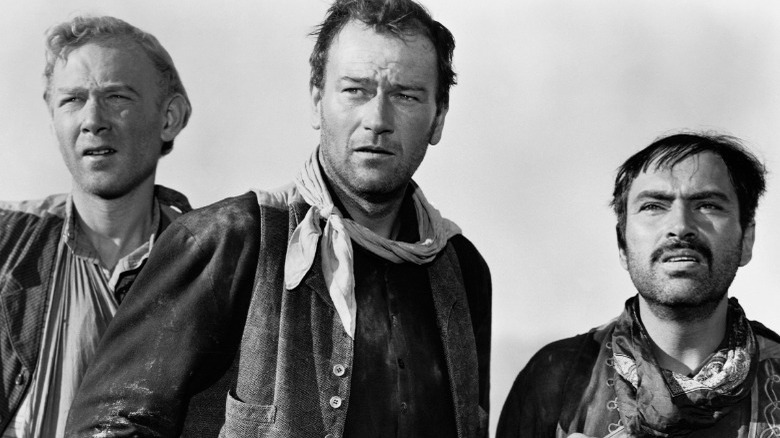
Another collaboration between John Wayne and John Ford, "3 Godfathers" is a western reimagining of the story of the Three Wise Men that exchanges Bethlehem for the Arizona desert (although anyone who has visited Zabriskie Point will notice that it was actually filmed in Death Valley, California). Riding through this vast milieu are criminals Bob (Wayne), Pete (Pedro Armendáriz), and William, who's better known as "The Abilene Kid" (Harry Carey Jr.). Arriving in Welcome, Arizona, the three men rob a bank and are chased out of town by Sheriff Buck Sweet (Ward Bond). Buck loses the outlaws, but not before shooting their water bag, leaving the trio dry in the desert.
Soon, Bob and his partners are caught in a struggle to survive. The scenery is classic Fordian beauty, but the film is honest about the danger of the oppressive landscape. Yet, even under this stress, the robbers prove their altruism when they find a pregnant woman dying in the back of a stranded stagecoach. After delivering the baby, the men become godfathers to the child and promise to get him to safety. "3 Godfathers" is another of Ford and Wayne's minor collaborations, but it's still an adequate western with a benevolent, biblical heart.
The Sands Of Iwo Jima

John Wayne was keen to impress American troops during WW2. In 1943 and 1944, he toured Australia and the Pacific Islands, appearing before crowds of battle-hardened veterans, who jeered and booed the strapping young actor. Wayne may have been a star, but he had not reached the peak fame that would charm Vietnam troops two decades later. He was of fighting age, too, which can't have endeared him to his audience, no matter his excuses for deferment. Wayne's third wife, Pilar Pallette, wrote that accusations of draft dodging haunted the actor for the rest of his life, causing him to build a "super patriot" image to "atone for staying at home."
"The Sands of Iwo Jima" is an early example of Wayne's campaign to build an all-American screen persona. Wayne stars as John M. Stryker, a hard case sergeant tasked with whipping his men into shape before they storm the island of Iwo Jima. Wayne goes hard in the role, trying his best to embody the blood-and-guts toughness of George Patton and Douglas MacArthur. The troops of '43 and '44 may not have cared for Wayne, but the Academy nominated him for best actor in a leading role.
Brannigan
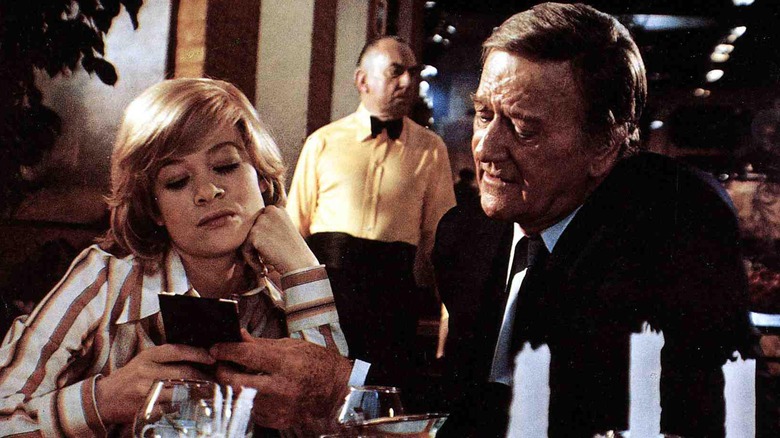
"Brannigan" is another of Wayne's "Dirty Harry"-inspired vehicles, but it learns from the mistakes of "McQ" by sticking to a simple formula: Wayne, a bad guy, and the streets of London. The location may be gimmicky, but these ingredients create what "McQ" should have been -- two hours of brawny, eye-winking fun. You know you're in for a good time during the gratuitously '70s credits sequence, which ogles a .38 special revolver while the soundtrack goes hard on rolling drums, brass instruments, and funky guitar chords that are, for want of a better term, all very "boom chicka wah-wah."
Now, "Brannigan" is not a shining example of the anti-hero cop genre, but it is a better time than it's given credit for. Much of that is down to the Duke, who plays it easy with a mix of machismo and playfulness, especially during a farcical pub brawl that's more Detective Frank Drebin than Inspector Harry Callahan. In addition, "Brannigan" doesn't miss an opportunity to make fun of the British, particularly their perceived arrogance and fussy manners, both of which are personified by Sir Charles Swann, a Scotland Yard commander played by a posh but plucky Richard Attenborough.
The Comancheros

"The Comancheros" is the penultimate film of director Michael Curtiz, one of the most prolific directors in cinematic history. His enormous filmography includes "Angels with Dirty Faces," the proverbial 1930s gangster flick; "The Adventures of Robin Hood," the swashbuckling Errol Flynn actioner; and "Casablanca," one of Hollywood's most celebrated films. "The Comancheros" hasn't endured like those three classics, but it is a robust farewell to the workmanlike director.
John Wayne stars in the film as Captain Jake Cutter, a Texas Ranger in 1843 who captures Paul Regret (Stuart Whitman), a fugitive wanted for the killing of a judge's son. Cutter transports Regret back to Louisiana until they run into the Comancheros, an outlaw gang who trade in weapons, liquor, and murder. It's effectively a buddy film in which men on opposite sides of the law must work together in the face of a greater adversary. In other words, it's "Midnight Run" with cowboy boots and spurs.
Big Jake

"Big Jake" premiered on May 26, 1971, John Wayne's 64th birthday. It was already his third western of the decade, and Wayne was so comfortable in felt cowboy hats that he must have known the genre by rote.
By this point, a mass of filmgoers had accused Wayne of playing the same character over and over again. The actor was fully aware of this, and mentioned it during an interview with Roger Ebert in 1969, reasoning that he played different characters in films such as "The Quiet Man" and "Yellow Ribbon." He also challenged his critics with an interesting comment on the qualities of movie stardom. "Thousands of good actors can carry a scene," Wayne said, "but a star has to carry the scene and still, without intruding, allow some of his character into it."
This point is relevant to "Big Jake." Everything about it is old hat, but through some combination of cadence, swagger, and legacy, John Wayne lifts a project that could have been thoroughly cut and paste. What is "Big Jake" about? Well, there's a hostage, a ransom, and a gunslinging posse hired to collect it. There's also a level of violence that is above that usually found in a John Wayne western, although still below that of Sergio Leone and Sam Peckinpah. Perhaps the most unique element of "Big Jake" is the appearance of Wayne's son, Patrick, who gives an angsty performance as Big Jake's first born.
The Sons Of Katie Elder

"The Sons of Katie Elder" is another western saga about land, feuds, and gunfights. The titular sons are John (Wayne), a notorious gunslinger; Tom (Dean Martin), a career gambler; Matt (Earl Holliman), a former shopkeeper; and Bud (Michael Anderson Jr.), an unruly student who wants to be like his siblings.
The brothers convene after the death of their mother, Katie Elder, an honorable matriarch beloved by all but the Hastings family, a cynical clan of gunsmiths who lay claim to the Elder ranch. They say that Bill, the Elder patriarch, lost the land during a game of blackjack, after which he was shot dead by an unknown killer. Smelling a rat, the Elder brothers investigate their father's death, leading them to an explosive confrontation with the Hastings men. It's a competent if unremarkable film with fair action scenes and a noticeably anxious turn from a young Dennis Hopper, who would become a counter-culture icon just four years later in "Easy Rider."
They Were Expendable

Released in December 1945, just three months after Japan's formal surrender, "They Were Expendable" takes audiences back to the Battle of the Philippines, which raged from December 8, 1941 to May 9, 1942 (via Britannica). This was a time long before Iwo Jima, Okinawa, and the numerous other American victories in the Pacific war. It was a time when America, shaken by the attack on Pearl Harbor, surrendered to the advance of a swift, organized, and merciless enemy.
Dire though this context may be, the Japanese are not the only enemies in this surprisingly cynical war film. Lt. "Rusty" Ryan (John Wayne) must also contend with his complacent superiors, who dismiss his squadron's PT boats as weak and ineffective. Respect is granted only once their base falls under heavy attack, which is obviously too late.
Much of the film's driving force comes not from Wayne but from Robert Montgomery, who received top billing on the picture. Like Wayne's other roles prior to "Red River," he is an easygoing presence, particularly when contrasted with Montgomery's fiery turn.
Rio Bravo

"Rio Bravo" is a film with many admirers. The western is one of John Carpenter's five favorite films and Quentin Tarantino described it as "one of the greatest 'hang out' movies of all time." I'm happy for Carpenter and Tarantino, I really am. I hope that any new viewer will share their enthusiasm, too. But for me, the "towering" qualities of "Rio Bravo" are elusive.
Personally, I did not want to hang out with Sheriff Chance (John Wayne), Dude (Dean Martin), Colorado (Ricky Nelson), Feathers (Angie Dickinson), Carlos (Pedro Gonzales) and Stumpy (Walter Brennan). Indeed, I found their exchanges all rather strained. Dude is washed up and strung out, Carlos fizzes with neurotic panic, and Feathers flits between seduction and histrionics. I wasn't gripped by their purpose, either, which is to hole up, organize, and confront Nathan Burdette, a violent rancher.
In case you were wondering, the similarities to "High Noon" here are intentional. Wayne and Hawks sought to counteract that film -- in which Gary Cooper must defend cowardly townsfolk alone -- by telling a story of kinship and crackpot defiance. The problem is the leisurely "hang out" pace. Both films hinge on an encroaching climactic shootout, but "High Noon" does so in real time, winding tension with much skill. "Rio Bravo," meanwhile, dilutes the prospect of conflict with about an hour of fraternizing. Still, personal reservations aside, "Rio Bravo" is an interesting landmark of the genre that must figure in any conversation about John Wayne.
The Searchers

I should get the other controversy out of the way. "The Searchers" is to John Ford what "Rio Bravo" is to Howard Hawks. It is a vaunted masterpiece that's hailed by some as not only the best film of John Wayne's career, but also the greatest example of the western genre (via AFI). Now, I like to go with the grain. I like to be engrossed by a film and connect with those who feel the same way, but "The Searchers" is another film that, while interesting, is less than the sum of its reputation.
Still, whatever you think of it, "The Searchers" is not just another mid-century western. The immediate distinction is Winton C. Hoch's painterly cinematography; the image of Wayne framed by the cabin doorway is the definitive moment of the actor's career. But what really elevates the film for many is the moral ambiguity of Ethan Edwards, John Wayne's darkest character.
Prickly, spiteful, and bigoted, Edwards personifies the film's vision of the frontier, a place where conflict is not a matter of good and evil but a painful cycle of death and enmity. However, the word "idea" is salient, for while "The Searchers" is dark in theme, it's not dark in execution. It's dated PG fare that's toothless by comparison to "The Wild Bunch," "Soldier Blue," and numerous other revisionist westerns.
How The West Was Won

By the end of the 1950s, cinema was in trouble. Television had eroded the studios' monopoly on visual entertainment and executives were scrambling to find an edge. Their solution was to tell big stories on a huge, sweeping scale, resulting in a wave of epics such as "Ben Hur," "Spartacus," and "How the West was Won," the first narrative feature film to be presented on a curved Cinerama screen (via Britannica).
"How the West Was Won" followed a similar format to "The Longest Day," released just under a month prior on October 4, 1962. Both films employed three directors, with "West" boasting the strongest line-up: John Ford, Henry Hathaway, and George Marshall. The national origin story is told in five chapters: "The Rivers," "The Plains," "The Civil War," "The Railroad," and "The Outlaws." John Wayne appears as General William Tecumseh Sherman in the Civil War section, delivering another of his gruff military performances.
"How the West Was Won" is the proverbial ensemble epic, so Wayne isn't afforded his usual star vehicle antics. However, the film is still an interesting piece of Hollywood mythmaking with gorgeous Technicolor visuals and a broadside of American A-list talent.
She Wore A Yellow Ribbon

"She Wore a Yellow Ribbon" is a building block in the legacies of John Wayne and John Ford, mostly because of the scenery, which was captured on the Arizona-Utah border. It wasn't the first time that Ford had shot a film in Monument Valley, but it was the first time that he took cinematographer Winton C. Hoch to the awesome sandstone buttes. Hoch captures the landscape's sweeping vistas at all times of day, with the most arresting imagery coming at dusk, when the sky turns mauve and is streaked by an awesome yellow haze.
Hoch's camerawork made a big impression on the western genre, but "Yellow Ribbon" was also a personal, important film for John Wayne. Like in "Red River" the year before, Wayne played a character some 20 years his senior, which required him to depict all the complexities and vulnerabilities that come with that. The Duke called his work as Captain Brittles "the best acting job I've done ... It's about the only picture I've been in where I could play a character that was a little apart from the image that has developed for me over the years on the screen" (via John Wayne: The Life and Legend).
Red River

"Red River" is something of a watershed moment in Wayne's career. The actor had spent the nine years since "Stagecoach," his star-making film, building the robust but easygoing persona that he'd use for the rest of his career. However, the character of Thomas Dunson introduced viewers to a new, darker John Wayne performance.
Dunson isn't an amiable gunslinger, but rather a rancher who manages his vast livestock with all the merciless ambition of John Dutton, the gruff patriarch of "Yellowstone." Dunson lives with his herd near the Rio Grande, at the southern end of the Chisholm Trail. He figures that if he is to get the best price for his herd, he must lead a huge cattle drive along the trail to Missouri, no matter how arduous.
Numerous people suffer Dunson's wrath on this journey, especially his adopted son, Matt (Montgomery Clift). It was the first time that Clift took his method acting from Broadway to the big screen, where it proved a sensitive counterweight to Wayne's bullying antagonist (via TCM).
The Quiet Man

In "The Quiet Man," John Wayne plays neither a cowboy nor a soldier. He instead appears as a retired boxer named Sean Thornton, who's returning home from Pittsburgh to Inisfree on the rugged west coast of Ireland.
Set in the 1920s, the film depicts Ireland as a lush land of rolling hills, stone bridges, and cheerful locals — cheerful apart from Will Danaher (Victor McLaglen), that is. Danaher resents Sean's intention to buy old Thornton land, but the real trouble arises when Sean falls for Danaher's sister, Mary Kate (Maureen O'Hara).
"The Quiet Man" was the second of John Wayne's films with Maureen O'Hara, a lifelong friend. Their chemistry is what makes "The Quiet Man" such an enduring classic, placing a weepy heart at the center of all the verdant beauty.
"Enduring" is not just an empty word; "The Quiet Man" made a lasting impact on the Irish village of Cong, where the film was shot. A lovely stone bridge that appears in the film is known today as "The Quiet Man Bridge," and the village center has a statue and a museum dedicated to preserving the film's memory (via Irish Post).
The Cowboys
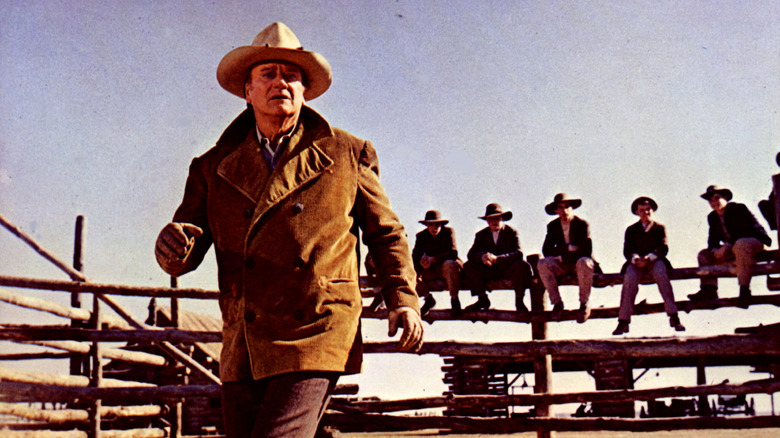
A highlight of Wayne's later years, "The Cowboys" features the Duke at his most softly patriarchal. That's because he's responsible for leading a group of teenage boys along a 400 mile cattle drive. No sane man would choose such an endeavor, but it's the only option available to Wil Andersen (Wayne), whose ranch hands have abandoned him for a gold rush.
The notion of "softly patriarchal" is subjective, of course. As viewers of "Hondo" will know, a John Wayne figure will gladly teach a boy to swim by throwing him into a pond. A similar moment occurs in "The Cowboys," in which Andersen confronts a stuttering boy whose condition endangered a friend stranded in a river. Instead of consoling the child, Andersen accuses him of not trying hard enough to save his friend, which riles the boy to the point of repeatedly insulting Anderson, at which point the stutter stops. It's an old school moment that a certain kind of father would nod at approvingly.
The nodding won't last for long, though, because after much toil on the long and arduous cattle drive, "The Cowboys" ends in a divisively fatal fashion.
Stagecoach
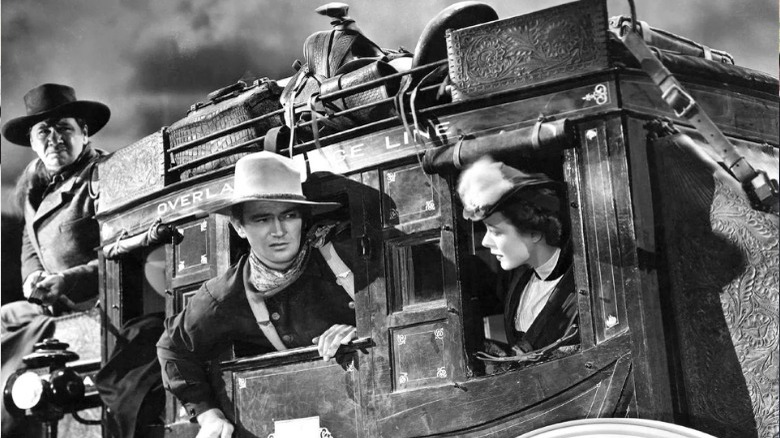
"Stagecoach" is usually cited as the beginning of John Wayne's canon, but his first leading role was actually in "The Big Trail," a pre-Code western from 1930. An ambitious and expensive production, "The Big Trail" bombed on release and put its 23-year-old star out to B-movie pasture for much of the decade (via TCM). Director John Ford helped cast Wayne in that doomed picture, and when the script for "Stagecoach" came together, he was adamant that John Wayne be given another chance. "He'll be the biggest star ever," Ford observed, "because he is the perfect everyman."
Ford's instincts were canny. "Stagecoach" brought Wayne to his biggest audience yet, showcasing the easy machismo he'd developed in the cinematic wilderness. The director also proved his own talents, capturing big characters and even bigger scenery in what became one of the most influential films of all time. Orson Welles said he watched the film 40 times in preparation for "Citizen Kane" (via Irish Film Institute).
Fort Apache
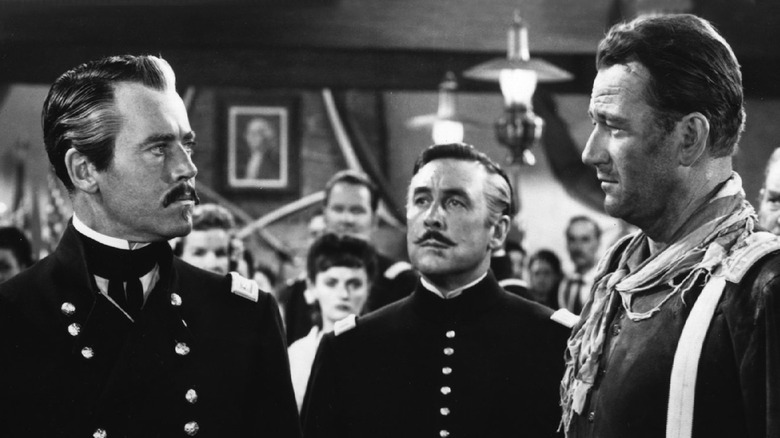
John Wayne is usually the master of his domain; he calls the shots and controls the environment. However, that is not true of "Fort Apache," the first film in John Ford's "cavalry trilogy." Here, Wayne plays Captain Kirby York, a civil war veteran who is strong, flexible, and yet subordinate to Lieutenant Colonel Owen Thursday (Henry Fonda), a patrician West Point graduate.
Thursday is chosen to lead the western outpost of Fort Apache, which is a job that requires tactful diplomacy with local Native Americans. However, the lieutenant colonel is ignorant of their customs and rejects any notion of co-operation. Instead, he rules the fort with dogmatic arrogance, leading the regiment into violent conflict with the Apache tribe. York butts heads with Thursday at every turn, but there is no overruling him. Thursday's Custer syndrome can end only one way, and it isn't pretty.
"Fort Apache" was novel for its time because it depicted Native Americans with nuance and empathy. We see the Apache not as villains but a community capable of reason and compromise, unlike Lieutenant Colonel Thursday.
The Longest Day
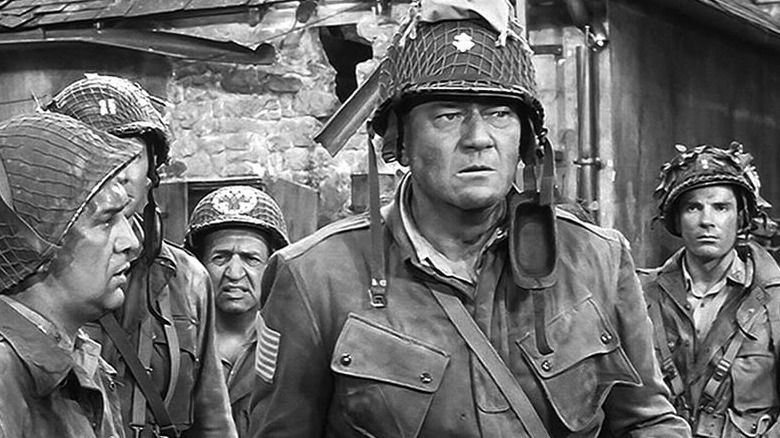
John Wayne is the first big actor to appear in "The Longest Day," a sweeping account of the D-Day invasion. The film may have a bleak docudrama style with an ostensible focus on historical accuracy, but it doesn't skimp on star power. The ensemble cast of "42 international stars" includes everyone from Richard Burton and Sean Connery to Robert Mitchum, Robert Ryan, and Henry Fonda.
Wayne drops his breezy charm to play Lieutenant Colonel Benjamin Vandervoort, delivering one of his more hard-edged performances. It's an appropriate choice, given the subject matter, but Wayne was perhaps overly serious when it came to the Second World War. For instance, when Steven Spielberg sent Wayne the script for his war comedy "1941," the aging star described it as "un-American" and telephoned the director to say, "Don't joke about World War II" (via Contact Music).
There are few laughs in "The Longest Day." The battle sequences may lack the bloody mayhem of "Saving Private Ryan," but the film still captures the terrible waste of war. There's no doubting the epic's sheer scale, either. Hordes of actors and extras storm the screen, captured overhead by some of the finest aerial photography of the period.
El Dorado

"El Dorado" is so similar to "Rio Bravo" that it's effectively a remake. However, it is an exception to the rule that all remakes are inadequate by being superior in casting, combat, and story detail.
First, there's the intriguing pairing of John Wayne and Robert Mitchum. They had both appeared in "The Longest Day," but "El Dorado" was the only time the two Golden Era men shared the screen. Mitchum opens the film as Sheriff J.P. Harrah, who paces across the screen with a badge and broad shoulders. This doesn't last, though. Harrah is the Dude character from "Rio Bravo," so the demon liquor is waiting for him. Compared to Dean Martin, Mitchum is more anguished, although there is no rendition of "My Rifle, My Pony, and Me" here.
Washed up though he may be, Harrah has a job to do when gunslinger Cole Thornton (Wayne) returns to El Dorado. Together, they must protect an upstanding family against a greedy landowner with designs on their ranch and their water supply. Assisting them is Mississippi (James Caan), an incendiary young man who's good with a knife but can't shoot a bullet into the proverbial broad side of a barn.
I'm not sure why Howard Hawks made "El Dorado." It is a rehash of a film that wasn't even 10 years old. But I'm glad he did, because it makes up for a celebrated classic that left me cold.
Baby Face

"Baby Face" is a timeless commentary on sexuality, ambition, and greed. It also features a terrific performance from Barbara Stanwyck, who avoids the stagey manner that dates even the best films of classic Hollywood.
Lily Powers is the titular "baby face," which is a pet name given to her by Jimmy McCoy, played by a 25-year-old John Wayne. McCoy is Lily's latest conquest and one of the more disposable ones, as he doesn't have the means to support her grandiose ambitions in reaching all the avarice New York City has to offer.
Her quest begins in a ramshackle speakeasy in Erie, Pennsylvania. She sits idly in this industrial milieu, barked at by her abusive father, who "offers" her to a local politician to avoid getting busted by prohibition agents. Lily knows how to stand up for herself, but the young woman remains adrift until Adolf, an eccentric cobbler, introduces her to Nietzsche's "will to power" philosophy. This awakens Lily's sexuality, which becomes a tool of manipulation and then outright Machiavellianism, leaving a trail of wrecked marriages and broken hearts in its wake.
Hatari!

"Rio Bravo" is the celebrated hang out film of John Wayne's career, but who would want to hang out in the Old West? Me, actually. But first I'd visit the characters of "Hatari!" for drinks, dinner, and fun in 1960s Tanganyika (present day Tanzania).
Wayne stars as Sean Mercer, a tough but amiable outdoorsman who must lead a crew of big game catchers. His team includes Kurt (Hardy Krüger), a German race car driver; Pockets (Red Buttons), a sprightly New York cabbie; and Dallas (Elsa Martinelli), an Italian photographer. The characters share a whimsical chemistry as they joke, flirt, eat, and care for the compound's exotic animals. You may not have seen "Hatari!," but you'll recognize Henry Mancini's score during the cheeky elephant sequence, which typifies the film's balmy escapism.
It's not all R&R, though. The film is punctuated by a series of hunt scenes in which the actors use trucks, lassos, and cages to capture a range of wild animals including zebras, giraffes, leopards, buffalo, and even a rhinoceros. The methods seem antiquated by contemporary standards, but "Hatari!" is less questionable than other films from the period, like Jacques Cousteau's documentary "The Silent World," in which the famed oceanographer detonates reefs, slaughters sharks, and attacks sperm whales with the bow of his ship.
True Grit

The film that won John Wayne the Oscar, "True Grit" is effectively a buddy film that pairs Rooster Cogburn (Wayne), a lumbering 6' 4" drunkard, with Mattie Ross (Kim Darby), a crusading teenager full of earnest resolve.
Their paths cross following the death of Mattie's father, Frank (John Pickard), who's shot dead by family acquaintance Tom Chaney (Jeff Corey). Dissatisfied by the sheriff's inaction, Mattie meets with Cogburn because he is said to have "true grit," which she believes to be a necessity for catching a villain like Chaney.
What follows is a power struggle between Mattie, Cogburn, and a Texas ranger named La Boeuf (Glen Campbell). This isn't all conflict and survivalism, though. Mattie may be half an orphan, but "True Grit" is fairly light in tone. Its 128 minutes breeze by thanks to the leads' charisma, the cat-and-mouse plotting, and the awesome Rocky Mountain adventurism. Glen Campbell's single is a delight, too.
The Shootist

The Duke's last film is also one of his best. In "The Shootist," Wayne plays J.B. Books, a gunfighter who, upon his arrival in Carson City, Nevada, is diagnosed with terminal cancer. The diagnosis is given by Dr. Hostetler (James Stewart), an old friend of Books who speaks frankly about the pain of Book's condition and concludes one of their meetings with a bleak suggestion: "I would not die a death like I just described ... not if I had your courage."
J.B. Books breaks no new ground for Wayne, but he brings the best of his grit and chivalry to the role, and it works well against Bond Rogers (Lauren Bacall), a matronly boarding house owner who hosts Books with icy reluctance. However, it is real world circumstances that really gives "The Shootist" its poignant, funeral pathos.
In 1964, John Wayne was diagnosed with lung cancer. He would be given the all clear, but only after losing much of his left lung (via New York Times). Wayne kept busy through the 1960s and into the new decade, but ill health loomed over the actor's psyche. "I have cancer," Wayne told his son Patrick during a bout of stomach pain. "I've had cancer before and I know how it feels and I have it now." In January 1979, the Duke was diagnosed with stomach cancer during gallbladder surgery. He died six months later.
The Man Who Shot Liberty Valance
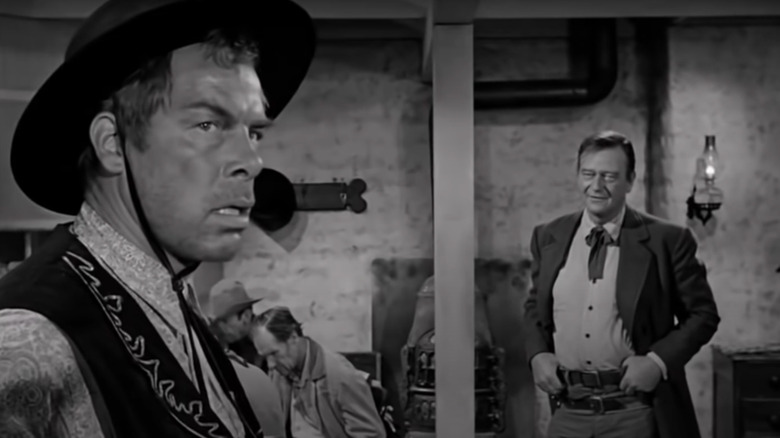
Many point to "The Searchers" as the greatest collaboration between John Ford and John Wayne, but for me it's "The Man Who Shot Liberty Valance," a story of violence and justice on the American frontier.
All developed governments have a monopoly on violence. Citizens grant this monopoly in return for safety and security. But how often does this arrangement fail us? How often does it enable those who may do us harm? The residents of Shinbone ask these questions as the harbingers of progress reach their town in the early 20th century, the most notable of which is Ransom Stoddard (James Stewart), a high-minded senator who speaks stridently about the rule of law. His earnest rhetoric may work on Capitol Hill, but it doesn't impress the people of Shinbone too much, especially Liberty Valance (Lee Marvin), the town's worst outlaw.
Marvin is brilliant in the role. Far from being a cackling stock character, Liberty Valance is a thoroughly hateful man. If he's not committing outright violence, he behaves like a playground bully. But Valance doesn't have free rein in Shinbone; he's stopped short by Tom Doniphon, performed by a career-best John Wayne.
Swaggering and violent but not unfair, Doniphon is precisely the figure you want in the absence of government authority. But is his violence preferable to Stoddard's careerism and bureaucracy? At what point does the law stop and murky pragmatism begin? These are the compelling themes of this premier American western.
Read this next: The 20 Best Westerns Of All Time
The post The 27 Best John Wayne films, ranked appeared first on /Film.
